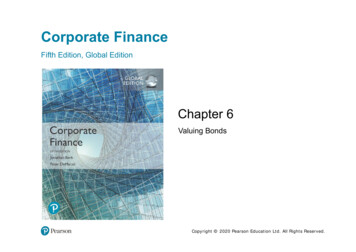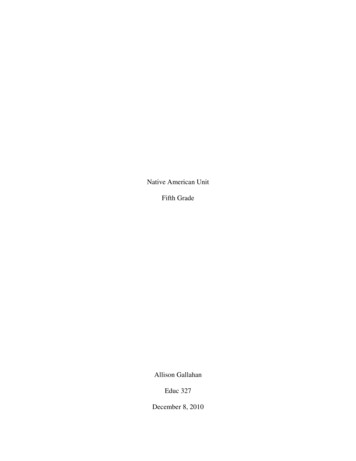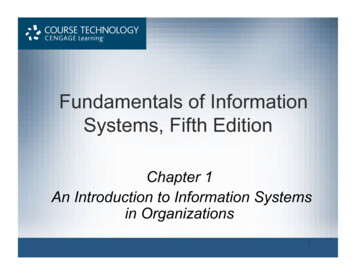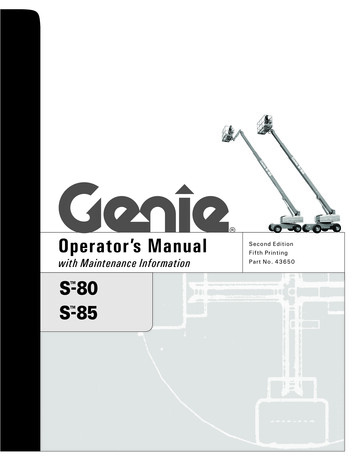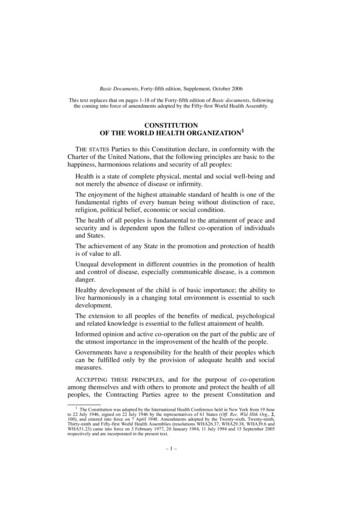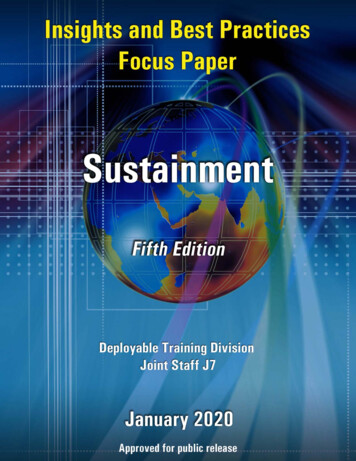
Transcription
Introduction to Fifth EditionSafety is critical to the tanker industry. The International Safety Guide for OilTankers and Terminals, or ISGOTT as it is now widely known, has becomethe standard reference work on the safe operation of oil tankers and theterminals they serve. To remain so, the Guide must keep abreast of changesin vessel design and operating practice and reflect the latest technology andlegislation.In this Fifth Edition, account has been taken of latest thinking on a number ofissues including the generation of static electricity and stray currents; the useof mobile phones and pagers which are now ever present but which did notwarrant a mention in the Fourth Edition; the use of new materials for mooringlines as emergency towing off pennants; the toxicity and the toxic effects ofbenzene and hydrogen sulphide; and the introduction of the InternationalSafety Management (ISM) Code. The Ship/Shore Safety Check List has beencompletely revised to better reflect the individual and joint responsibilities ofthe tanker and the terminal.The Guide is now divided into four sections: General Information; TankerInformation; Terminal Information and the Management of the Tanker andTerminal Interface. Care has been taken to ensure that where the guidancegiven in previous editions was still relevant and fit-for purpose it has not beenchanged or deleted in moving to the new format.We believe that ISGOTT continues to provide the best technical guidance ontanker and terminal operations. All operators are urged to ensure that therecommendations in this guide are not only read and fully understood, butalso followed.
PURPOSE AND SCOPEThis Guide makes recommendations for tanker and terminal personnel on the safecarriage and handling of crude oil and petroleum products on tankers and at terminals. Itwas first published in 1978 by combining the contents of the ‘Tanker Safety Guide(Petroleum)’ published by the International Chamber of Shipping (ICS) and the‘International Oil Tanker and Terminal Safety Guide’ published on behalf of the OilCompanies International Marine Forum (OCIMF). In producing this Fifth Edition, thecontent has again been reviewed by these organisations, together with the InternationalAssociation of Ports and Harbours (IAPH), to ensure that it continues to reflect current bestpractices and legislation. The scope has been extended by increasing the amount ofinformation on terminal safety systems and activities. This has been achieved, in part, byincorporating information from the OCIMF publication ‘Guide on Marine Terminal FireProtection and Emergency Evacuation’.This latest edition takes account of recent changes in recommended operatingprocedures, particularly those prompted by the introduction of the International SafetyManagement (ISM) Code, which became mandatory for tankers on 1st July 1998. One ofthe purposes of the Guide is therefore to provide information that will assist companies inthe development of a Safety Management System to meet the requirements of the ISMCode.This guide does not provide a definitive description of how tanker and terminal operationsare conducted. It does provide guidance and examples of how certain aspects of tankerand terminal operations may be managed. Effective management of risk demandsprocesses and controls that can quickly adapt to change. Therefore the guidance given is,in many cases, intentionally non prescriptive and alternative procedures may be adoptedby some operators in the management of their operations. These alternative proceduresmay exceed the recommendations contained in this guide. Where an operator hasadopted alternative procedures, they should follow a risk based management process thatmust incorporate systems for identifying and assessing the risks and for demonstratinghow they are managed. For shipboard operations, this course of action must satisfy therequirements of the ISM Code.It should be borne in mind that, in all cases, the advice in the guide is subject to any localor national terminal regulations that may be applicable, and those concerned shouldensure that they are aware of any such requirements.It is recommended that a copy of the guide be kept — and used — on board every tankerand in every terminal to provide advice on operational procedures and the sharedresponsibility for port operations.Certain subjects are dealt with in greater detail in other publications issued by IMO or byICS, OCIMF or by other maritime industry organisations. Where this is the case anappropriate reference is made, and a list of these and other related publications is given inthe bibliography.It is not the purpose of the guide to make recommendations on design or construction.Information on these matters may be obtained from national authorities and fromauthorised bodies such as Classification Societies. Similarly, the guide does not attemptto deal with certain other safety related matters — e.g. navigation, helicopter operations,and shipyard safety — although some aspects are inevitably touched upon. It should alsobe noted that the guide does not relate to cargoes other than crude oil that is carried in oiltankers and combination carriers and petroleum products that are carried in oil tankers,
chemical tankers, gas carriers and combination carriers certified for the carriage ofpetroleum products. It therefore does not cover the carriage of chemicals or liquefiedgases, which are the subject of other industry guides. Finally the guide is not intended toencompass offshore facilities including FPSOs and FSUs. Operators of such units may,however, wish to consider the guidance given to the extent that good tanker practice isequally applicable to their operations.Comments and suggestions for improvement are always welcome for possible inclusion infuture editions. They may be addressed to any of the three sponsoring organisations, asfollows: International Chamber of Shipping12, Carthusian Street,London EC1M 6EBUnited Kingdom.Oil Companies International Marine Forum27, Queen Anne’s Gate,London SW1H 9BUUnited Kingdom.International Association of Ports and Harbours7th Floor South Tower,New Pier Takeshiba,1-16-1, Kaigan,Minato-kuTokyo 105-0022Japan.
CONTENTSFOREWORD TO FIFTH EDITIONINTRODUCTION TO FIFTH EDITIONPURPOSE AND SCOPEBIBLIOGRAPHYDEFINITIONSPART 1: GENERAL INFORMATION11.1HAZARDS OF oductionLiquid PetroleumPetroleum GasesMaterial Safety Data Sheets (MSDS)Benzene and Other Aromatic HydrocarbonsHydrogen Sulphide (H2S)MercaptansGasolines Containing Tetraethyl Leas (TEL) or Tetramethyl Lead (TML)Inert GasOxygen DeficiencyGas y ClassificationGas DensityIntroductionMeasurement of Hydrocarbon ConcentrationFlammable Gas Monitors (Explosimeter)Tankscope (Non-Catalytic Heated Filament Gas Indicator)Inferometer (Refractive Index Meter)Infra-Red InstrumentsMeasurement of Low Concentrations of Toxic GasesFixed Gas Detection InstallationsMeasurement of Oxygen ConcentrationsUse of Oxygen AnalysersMulti Gas InstrumentsPersonal Gas MonitorsGas Sample Lines and Sampling ProceduresFilters in Sample LinesHydrocarbon Gas Evolution and onGas Evolution and VentingGas DispersionVariables Affecting DispersionMinimising Hazards from Vented GasLoading Very High Vapour Pressure Cargoes
1.5Pyrophoric Iron Sulphide1.5.11.5.21.5.31.6Pyrophoric Iron SulphideFormation of PyrophorsPrevention of Pyrophoric Ignition in Inerted Cargo TanksThe Hazards Associated with the Handling, Storage and Carriage ofResidual Fuel Oils1.6.11.6.21.6.31.6.41.6.5GeneralNature of HazardFlashpoint and Headspace Flammability MeasurementPrecautionary MeasuresHydrogen Sulphide Hazard2BASIC PROPERTIES OF PETROLEUM2.1Vapour Pressure2.1.12.1.22.2True Vapour PressureReid Vapour GeneralFlammable LimitsEffect of Inert Gas on FlammabilityTests for FlammabilityFlashpointFlammability Classification of Petroleum2.3Density of Hydrocarbon Gases3STATIC ELECTRICITY3.1Principles of Electrostatics3.1.13.1.23.1.33.1.43.1.53.2General Precautions Against Electrostatic Hazards3.2.13.2.23.2.33.3SummaryCharge SeparationCharge AccumulationElectrostatic DischargeElectrostatic Properties of Gases and MistsOverviewBondingAvoiding Loose Conductive ObjectsOther Sources of Electrostatic tersFixed Equipment in Cargo TanksFree Fall in TanksWater MistsInert GasDischarge of Carbon DioxideClothing and FootwearSynthetic Materials4GENERAL HAZARDS FOR SHIP AND TERMINAL4.14.2General PrinciplesControl of Potential Ignition Sources4.2.14.2.24.2.34.2.44.3Naked FlamesSmokingGalley Stoves and Cooking AppliancesEngine and Boiler RoomsPortable Electrical Equipment4.3.1General
4.3.24.3.34.3.44.3.54.3.64.4Management of Electrical Equipment and Installations in Dangerous Areas4.4.14.4.24.4.34.4.44.4.54.5GeneralDangerous and Hazardous AreasElectrical EquipmentInspection and Maintenance of Electrical EquipmentElectrical Repairs, Maintenance and Test Work at TerminalsUse of Tools4.5.14.5.24.64.74.8Lamps or Other Electrical Equipment on Flexible Cables (Wandering Leads)Air Driven LampsFlashlights (Torches), Lamps and Portable Battery Powered EquipmentCamerasOther Portable Electrical EquipmentGrit Blasting and Mechanically Powered ToolsHand ToolsEquipment Made of AluminiumCathodic Protection Anodes in Cargo TanksCommunications lShip’s Radio EquipmentShip’s Radar EquipmentAutomatic Identification Systems (AIS)TelephonesMobile TelephonesPagers4.94.10Spontaneous CombustionAuto-Ignition5FIRE-FIGHTING5.15.2Theory of Fire-FightingTypes of Fire and Appropriate Extinguishing Agents5.2.15.2.25.2.35.3Class A – Ordinary (Solid) Combustible Material FiresClass B – Fires Involving Flammable and Combustible Hydrocarbon LiquidsClass C- Electrical Equipment FiresExtinguishing Agents5.3.15.3.25.3.3Cooling AgentsSmothering AgentsFlame Inhibiting Agents6SECURITY6.16.26.36.4GeneralSecurity AssessmentsResponsibilities under the ISPS CodeSecurity PlansPART 2: TANKER INFORMATION77.1SHIPBOARD SYSTEMSFixed Inert Gas System7.1.17.1.27.1.37.1.47.1.5GeneralSources of Inert GasComposition and Quality of Inert GasMethods of Replacing Tank AtmospheresCargo Tank Atmosphere Control
Application to Cargo Tank OperationsPrecautions to be Taken to Avoid Health HazardsCargo Tank ProtectionEmergency Inert Gas SupplyProduct Carriers Required to be Fitted with an Inert Gas SystemCold Weather Precautions for Inert Gas SystemsInert Gas System FailureInert Gas Plant RepairsVenting SystemsCargo and Ballast Systems7.3.17.3.27.3.3Operation ManualCargo and Ballast System IntegrityLoading Rates7.47.57.6Power and Propulsion SystemsVapour Emission Control (VEC) SystemsStern Loading and Discharge Arrangements8SHIP’S EQUIPMENT8.1Shipboard Fire-Fighting Equipment8.1.18.1.28.1.38.1.48.2Gas GeneralTanker Fixed Fire-Fighting Installations – CoolingTanker Fixed Fire-Fighting Installations – SmotheringPortable Fire ExtinguishersIntroductionSummary of Gas Testing TasksThe Provision of Gas Measurement InstrumentsAlarm Functions on Gas Measuring InstrumentsSampling LinesCalibrationOperational TestingDisposable Personal Gas MonitorsLifting Equipment8.3.18.3.2Inspection and MaintenanceTraining9MANAGEMENT OF SAFETY AND EMERGENCIES9.19.2The International Safety Management (ISM) CodeSafety Management Permit to Work System – StructurePermit to Work Systems – Principles of OperationPermit to Work FormsOperations MeetingsHot Work9.4.19.4.29.4.39.4.49.59.69.79.8Risk AssessmentPermit to Work SystemsControl of Hot WorkChecks by the Responsible OfficerHot Work Inside the Machinery SpaceHot Work Outside the Machinery SpaceWelding and Burning EquipmentOther Hazardous TasksManagement of ContractorsRepairs at a Facility Other Than a Shipyard9.8.1Introduction
119.8.129.8.139.8.149.9GeneralSupervision and ControlPre-Arrival PlanningMooring ArrangementsShore FacilitiesPre-Work Safety MeetingWork PermitsTank ConditionCargo LinesFire-Fighting PrecautionsSafety OfficerSafe AccessHot WorkShipboard Emergency Management9.9.19.9.29.9.3GeneralTanker Emergency PlanActions in the Event of an Emergency10ENCLOSED SPACE ENTRY10.110.2Enclosed SpacesHazards of Enclosed 10.510.6Assessment of RiskRespiratory HazardsHydrocarbon VapoursToxic GasesOxygen DeficiencyProducts of Inert GasAtmosphere Tests Prior to EntryControl of Entry into Enclosed SpacesSafeguards for Enclosed Space EntryEmergency Procedures10.6.1 Evacuation from Enclosed Spaces10.6.2 Rescue from Enclosed Spaces10.6.3 Resuscitation10.710.8Entry into Enclosed Spaces with Atmospheres Known or Suspected to beUnsafe for EntryRespiratory Protective 710.8.810.9Work in Enclosed f Contained Breathing Apparatus (SCBA)Air Line Breathing ApparatusEmergency Escape Breathing DeviceCartridge or Canister Face MasksHose Mask (Fresh Air Breathing Apparatus)Equipment MaintenanceStowageTrainingGeneral RequirementsOpening up Equipment and FittingsUse of ToolsElectric Lights and Electrical Equipment UseRemoval of Sludge, Scale and SedimentWork BoatsPumproom Entry Precautions10.10.1 Ventilation10.10.2 Pumproom Entry Procedures10.11Pumproom Operational Precautions10.11.1 General Precautions10.11.2 Cargo and Ballast Line Draining Procedures
10.11.310.11.410.11.510.11.610.11.7Routine Maintenance and Housekeeping IssuesMaintenance of Electrical Equipment in the PumproomInspection and Maintenance of Pumproom Ventilation FansTesting of Alarms and TripsMiscellaneous11SHIPBOARD OPERATIONS11.1Cargo 1.211.3Stability, Stress, Trim and ‘Sloshing’ ConsiderationsTank Cleaning11.3.111.3.211.3.311.3.411.4GeneralAdvance NoticeTank Washing MachinesControl of Tank AtmospherePrecautions Against Leakage from the Washing SystemAvoidance of Oil/Water MixturesIsolation of the Tank Cleaning HeaterControl of Vapour EmissionsSupervisionCautionary NoticeBallast GeneralGas Free for Entry without Breathing ApparatusProcedures and PrecautionsGas Testing and MeasurementFixed Gas Freeing EquipmentPortable FansVentilating Double Hull Ballast TanksGas Free in Preparation for Hot WorkCrude Oil 1.5.811.5.911.5.1011.6GeneralSupervision and PreparationCargo Tank Washing and CleaningPrecautions for Tank WashingGas 1.4.811.5GeneralSetting of Lines and ValvesValve OperationPressure SurgesButterfly and Non-Return (Check) ValvesLoading ProceduresLoading Static Accumulator OilsLoading Very High Vapour Pressure CargoesLoading Cargoes Containing Hydrogen Sulphide (H2S)Loading Heated ProductsLoading from the Top (Sometimes known ‘Loading Overall’)Loading at Terminals having Vapour Emission Control SystemsGeneral Discharging ProceduresPipeline and Hose Clearing Following Cargo OperationsIntroductionGeneralLoading Cargo Tank BallastLoading Segregated BallastDeballasting in PortDischarging Segregated BallastCargo Measurement, Ullaging, Dipping and Sampling11.7.1 General11.7.2 Measuring and Sampling Non-inerted Tanks11.7.3 Measuring and Sampling Inerted Tanks
11.7.4 Measuring and Sampling Cargoes Containing Toxic Substances11.7.5 Closed Gauging for Custody Transfer11.8Ship To Ship Transfer11.8.111.8.211.8.311.8.411.8.511.9Ship to Ship TransfersShip to Barge TransfersShip to Ship Transfers Using Vapour BalancingShip to Ship Transfers Using Terminal FacilitiesShip to Ship Electric CurrentsShip’s Moorings11.9.1 General11.9.2 Tanker’s Mooring Equipment11.9.3 Tanker Mooring Operations12CARRIAGE AND STORAGE OF HAZARDOUS MATERIALS12.112.2Liquefied GasesShip’s ChemicalsCleaning LiquidsCargo SamplesOther Materials12.4.1 Sawdust, Oil Absorbant Granules and Pads12.4.2 Garbage12.5Packaged 2.5.812.5.9Petroleum and other Flammable LiquidsDangerous GoodsEntry into HoldsPortable Electrical EquipmentSmothering Type Fire Extinguishing SystemsFire-Fighting PrecautionsForecastle Spaces and Midship StoresDeck CargoBarges13HUMAN ELEMENT CONSIDERATIONS13.113.213.3Manning LevelsTraining and ExperienceHours of Rest13.3.1 Statutory Requirements13.3.2 Fatigue13.4Drug and Alcohol Policy13.4.1 Industry Guidelines13.4.2 Control of Alcohol13.4.3 Drug and Alcohol Testing Programs13.5Drug Trafficking14SPECIAL SHIP TYPES14.1Combination Carriers14.1.114.1.214.1.314.1.414.1.5General InstructionsTypes of Combination CarriersSlack Holds in Combination CarriersSloshingLongitudinal Stress
1314.2Venting of Cargo HoldsInert GasHatch CoversTank WashingCarriage of Slops when Trading a Dry Bulk CarrierLeakage into Ballast Tanks on Combination CarriersTesting of Cargo Tanks and Enclosed Spaces on Dry Bulk VoyagesCargo Changeover Check ListsLPG Carriers Carrying Petroleum GeneralProduct LimitationsPre-Loading PreparationsLoading of Pentane Plus and NaphthaCargo SamplingLoading, Carriage and Discharge ProceduresTank Cleaning/ Changeover ProceduresPART 3: TERMINAL INFORMATION15TERMINAL MANAGEMENT AND ORGANISATION15.115.215.315.415.5ComplianceHazard Identification and Risk ManagementOperating ManualTerminal Information and Port RegulationsSupervision and Control15.5.115.5.215.5.315.5.415.6Manning LevelsDe-Manning of BerthsChecks During Cargo HandlingTrainingVessel and Berth Compatibility15.6.115.6.215.6.315.6.4Maximum DraftMaximum DisplacementLength Overall (LOA)Other Criteria15.7Documentation16TERMINAL OPERATIONS16.116.2Pre-Arrival CommunicationsMooring16.316.4Limiting Conditions for OperationsShip/Shore Access16.2.1 Mooring 716.4.816.516.616.716.8GeneralAccess EquipmentProvision of Ship/Shore AccessSiting of GangwaysSafety NetsRoutine MaintenanceUnauthorised PersonsPersons Smoking or IntoxicatedDouble BankingOver-The-Tide Cargo OperationsOperations where the Vessel is not Always AfloatGeneration of Pressure Surges in Pipelines16.8.1 Introduction
16.8.2 Generation of a Pressure Surge16.9Assessment of Pressure Surges16.9.1 Effective Valve Closure Time16.9.2 Derivation of Total Pressure in the System16.9.3 Overall System Design16.10Reduction of Pressure Surge Hazard16.10.1 General Precautions16.10.2 Limitation of Flow Rate to Avoid the Risk of a Damaging Pressure Surge16.11Pipeline Flow Control as a Static Precaution16.11.116.11.216.11.316.11.4GeneralFlow Control RequirementsControlling Loading RatesDischarge into Shore Installations17TERMINAL SYSTEMS AND EQUIPMENT17.117.2Siting of Electrical EquipmentFendering17.3Lifting Equipment17.2.1 Fender Operating Limits for Berthing17.3.1 Inspection and Maintenance17.3.2 Training in the Use of Lifting Equipment17.417.5LightingShip/Shore Electrical Isolation17.5.117.5.217.5.317.5.417.5.6GeneralShip to Shore Electric CurrentsSea IslandsShip/Shore Bonding CablesInsulating Flange17.6Earthing and Bonding Practice in the Terminal18CARGO TRANSFER EQUIPMENT18.1Metal Cargo .818.1.918.1.1018.2Cargo 2.818.2.918.2.1018.2.1118.2.1218.2.1318.3Operating EnvelopeForces on ManifoldsTanker Manifold RestrictionsInadvertent Filling of Arms while ParkedIce FormationMechanical CouplersWind ForcesPrecautions when Connecting ArmsPrecautions while Arms are ConnectedPowered Emergency Release Couplings (PERCs)GeneralTypes and ApplicationsPerformanceMarkingFlow VelocitiesInspection, Testing and Maintenance Requirements for Dock Cargo HosesHose Flange StandardsOperating ConditionsExtended StorageChecks Before Hose HandlingHandling, Lifting and SuspendingAdjustment During Cargo Handling OperationsSubmarine and Floating Hose StringsVapour Emission Control Systems
1919.1SAFETY AND FIRE PROTECTIONSafety19.1.1 Design Considerations19.1.2 Safety Management19.1.3 Permit to work Systems – General Considerations19.2Marine Terminal Fire .719.2.819.2.919.2.1019.3GeneralFire Prevention and IsolationFire Detection and Alarm SystemsAutomatic Detection SystemsSelection of Fire DetectorsLocation and Spacing of Fire DetectorsFixed Combustible and Toxic Gas DetectorsLocating Fixed Combustible and Toxic Gas DetectorsFixed Combustible and Toxic Gas AnalysersFire Extinguishing System CapabilityAlarm and Signalling Systems19.3.119.3.219.3.319.3.419.3.5Types of Alarm SystemsTypes of SignalAlarm and Signalling System DesignAlternative Alarm and Signalling System DesignDetection and Alarm System Circuit Design – Fire Extinguishing SystemInterface19.3.6 Electric Power Sources19.4Detection and Alarm Systems at Terminal Handling Crude Oil andPetroleum Products19.4.1 General19.4.2 Control Rooms/ Control Buildings19.5Fire Protection19.5.1 Terminal Fire Fighting Equipment19.5.2 Portable and wheeled Fire Extinguishers and Monitors19.5.3 Terminal Fixed Fire Fighting Equipment19.619.719.8Water-borne Fire Fighting EquipmentProtective ClothingAccess for Fire Fighting Services20EMERGENCY PREPAREDNESS20.120.2OverviewTerminal Emergency Planning – Plan Components and .720.2.820.3PreparationControlCommunications and AlarmsSite Plans and MapsAccess to EquipmentTraffic Movement and ControlOutside ServicesTraining for EmergenciesDefinition and Hierarchy of Emergencies20.3.1 General20.3.2 Hierarchy of Emergencies20.3.3 Assessing Risks20.4Emergency Response Plan20.4.1 Format20.4.2 Preparation
20.4.3 Resource Availability20.4.4 Miscellaneous Organisational Items20.5Emergency Removal of Tanker from Berth21EMERGENCY EVACUATION21.1General21.1.1 Ship Evacuation21.1.2 Non-Essential Personnel21.2Evacuation and Personnel Escape y and Secondary Escape RoutesProtection of PersonnelBoat AccessAvailability of Rescue CraftLife Saving AppliancesSurvival CraftTraining and DrillsPART 4 – OPERATIONS CONTROLLED UNDERSHIP/SHORE INTERFACE MANAGEMENT22COMMUNICATIONS22.1Procedures and Precautions22.1.1 Communications Equipment22.1.2 Communications Procedures22.1.3 Compliance with Terminal and Local Regulations22.2Pre-Arrival Exchange of Information22.2.122.2.222.2.322.2.422.3Exchange of Security InformationTanker to Appropriate Competent AuthorityTanker to TerminalTerminal to TankerPre-Berthing Exchange of Information22.3.1 Tanker to Terminal and/or Pilot22.3.2 Terminal and/or Pilot to Tanker22.4Pre-Transfer Exchange of Information22.4.1 Tanker to Terminal22.4.2 Terminal to Tanker22.522.622.7Agreed Loading PlanAgreed Discharge PlanRepairs22.7.1 Repairs on the Tanker22.7.2 Repairs on the Terminal22.7.3 Use of Tools on the Tanker or Terminal23MOORING23.123.223.3Personnel SafetySecurity of MooringsPreparations for Arrival23.3.1 Tanker’s Mooring Equipment23.3.2 Use of Tugs23.3.3 Emergency Use of Tugs
23.4Mooring at Jetty Berths23.4.1 Type and Quality of Mooring Lines23.4.2 Management of Moorings at Alongside Berths23.5Berthing at Buoy Moorings23.5.123.5.223.5.323.5.4Mooring at Conventional Multi Buoy MooringsMooring at Single Point Moorings (SPM)Management of Moorings at Buoy BerthsAdditional Moorings24PRECAUTIONS DURING CARGO HANDLING24.124.224.3External Openings in SuperstructuresCentral Air Conditioning and Ventilation SystemsOpenings in Cargo n of Ship’s Cargo Tanks Before LoadingSegregated Ballast Tank LidsShip and Shore Cargo Connections24.6.124.6.224.6.324.6.424.7GeneralSea and Overboard Discharge ValvesScupper PlugsSpill ContainmentShip and Shore Cargo and Bunker Pipelines not in UseFire Fighting EquipmentProximity to Other Vessels24.9.124.9.224.9.324.9.424.10Flange ConnectionsRemoval of Blank FlangesReducers and SpoolsLightingAccidental Oil Spillage and Leakage24.7.124.7.224.7.324.7.424.7.524.824.9Cargo Tank LidsSighting and Ullage PortsCargo Tank Vent OutletsTank Washing OpeningsTankers at Adjacent BerthsGeneral Cargo Ships at Adjacent BerthsTanker Operations at General Cargo BerthsTugs and Other Craft AlongsideNotices24.10.1 Notices on the Tanker24.10.2 Notices on the Terminal24.1124.1224.13Manning RequirementsControl of Naked Flames and Other Potential Ignition SourcesHelicopter Operations25BUNKERING OPERATIONS25.125.225.325.4GeneralBunkering ProceduresThe Bunkering OperationThe Bunkering Safety Check List25.4.1 General25.4.2 Guidelines for Use25.4.3 Bunkering Safety Check List26SAFETY MANAGEMENT26.1Climatic Conditions
26.1.1 Terminal Advice of Adverse Weather Conditions26.1.2 Still Wind Conditions26.1.3 Electrical Storms (Lightning)26.2Personnel Safety26.2.126.2.226.2.326.2.426.3The Ship/Shore Safety Check List26.3.126.3.226.3.326.3.426.426.5Personal Protective Equipment (PPE)Slip and Fall HazardsPersonal HygieneClothing Made of Synthetic MaterialsGeneralGuidelines for UseShip/Shore Safety Check ListExample Safety LetterGuidelines for Completing the Ship/Shore Safety Check ListEmergency Procedures26.5.126.5.226.5.326.5.4Fire or Explosion on a BerthFire on a Tanker at a TerminalInternational Shore Fire ConnectionEmergency Release Procedures
DEFINITIONSFor the purpose of this safety guide the following definitions apply:AdministrationMeans the Government of the State whose flag the ship is entitled to fly.Anti-static additiveA substance added to a petroleum product to raise its electrical conductivity to a safe level above 50picoSiemens/metre (pS/m) to prevent accumulation of static electricity.Approved equipmentEquipment of a design that has been tested and approved by an appropriate authority, such as agovernment department or classification society. The authority should have certified the equipment assafe for use in a specified hazardous atmosphere.Auto-ignitionThe ignition of a combustible material without initiation by a spark or flame, when the material hasbeen raised to a temperature at which self-sustaining combustion occurs.BondingThe connecting together of metal parts to ensure electrical continuity.Brush dischargeA brush discharge is a diffuse discharge from a single blunt conductor that is more rapid than coronaand releases more energy. It is possible for a brush discharge to ignite gases and vapours.Cathodic protectionThe prevention of corrosion by electrochemical techniques. On tankers it may be applied eitherexternally to the hull or internally to the surfaces of tanks. At terminals, it is frequently applied to steelpiles and fender panels.ClingageOil remaining on the walls of a pipe or on the internal surfaces of tanks after the bulk of the oil hasbeen removed.Cold workWork which cannot create a source of ignition.Combination carrierA ship which is designed to carry either petroleum cargoes or dry bulk cargoes.Combustible (also referred to as ‘Flammable’)Capable of being ignited and of burning. For the purposes of this guide, the terms ‘combustible’ and‘flammable’ are synonymous.Combustible gas indicatorAn instrument for measuring the composition of hydrocarbon gas/air mixtures, usually giving theresult as a percentage of the lower flammable limit (LFL).CompanyThe owner of a ship or any other organisation or person such as the manager, or the bareboatcharterer who has assumed the responsibility for the operation of the ship from the owner of the ship.This includes the duties and responsibilities imposed by the ISM Code.
Competent PersonA person who has been adequately trained to undertake the tasks they are required to perform withintheir job description. For personnel in the shipping industry they should be able to demonstrate thiscompetence by the production of certificates approved by the vessel’s Administration.CoronaA diffuse discharge from a single sharp conductor (less than 5 mm in diameter) that slowly releasessome of the available energy. Generally corona is incapable if igniting a gas like propane or vapourslike those given-off by gasoline. Corona may ignite vapours like hydrogen or acetylene, which requiremuch lower energies for ignition.Dangerous areaAn area on a tanker which for the purposes of the installation and use of electrical equipment isregarded as dangerous.Designated Person AshoreUnder the ISM Code, is a person or persons ashore within a ship’s managing office (Company) withdirect access to the highest levels of management, who has or have the responsibility and theauthority to monitor the safety and pollution prevention aspects of the operation of each ship, and toensure that adequate resources and shore-based support are applied, as required.Dry chemical powderA flame inhibiting powder used in fire fighting.Earthing (also referred to as ‘Grounding’)The electrical connection of equipment to the main body of the earth to ensure that it is at earthpotential. On board ship, the connection is made to the main metallic structure of the ship which is atearth potential because of the conductivity of the sea.Enclosed spaceA space which has the following characteristics: Limited Openings for entry and exit; Unfavourable natural ventilation; and Is not designed for continuous worker occupancy.This includes, but is not limited to, cargo spaces, double bottoms, fuel tanks, ballast tanks, pumprooms, compressor rooms, cofferdams, void spaces, duct keels, inter-b
6 SECURITY 6.1 General 6.2 Security Assessments 6.3 Responsibilities under the ISPS Code 6.4 Security Plans PART 2: TANKER INFORMATION 7 SHIPBOARD SYSTEMS 7.1 Fixed Inert Gas System 7.1.1 General 7.1.2 Sources of Inert Gas 7.1.3 Composition and Quality


